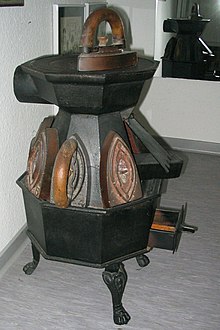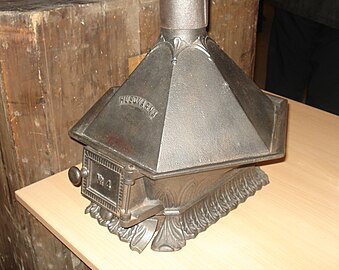Iron stove
The iron oven , also known as the flattening oven , is a special oven from the 19th century. It differs from a cooking oven in that it has an attachment on which one or more flat irons can be heated up at the same time . The latter was used by hat makers , ironers and tailors who had to deal with large amounts of ironing.
Iron stoves came in a variety of designs and sizes, and were elongated or polygonal in shape. Each stove could work at least as many people as there were iron fans, each requiring a second iron to change. However, a worker could iron most efficiently if she had six irons available, in order to change them frequently and thus to achieve a constant heat of the iron.
In the 18th century, irons were still heated on a so-called charcoal fire, which were clay or cast iron basins on which two irons could be placed and heated. In some places, there was the so-called Plätt pots (also Platt pots ), these bolts for irons were heated directly into the hot coals. The disadvantage was that the irons became sooty, but above all the harmful gases spread in the workrooms and were inhaled.
history
In Vienna, Berlin, Hamburg and Fürth bathing and washing facilities based on the English model were built in the middle of the 19th century, where large ovens were used to heat 30–40 irons.
Smaller models consisted of a detachable attachment for an iron that was hung in or placed on the stove, depending on whether you wanted to heat the room with this stove or not. The so-called flat iron warmer was a cast iron plate with two to three openings for hanging the flat iron, which could be exchanged for the stove rings of the economy stove . The heating of the flat irons was laborious, in 20 minutes you could heat about four or more irons and keep them hot. There were also irons with removable handles and numbering to identify which iron had been heated the longest. There was also a numbered sorting of the irons according to weight, with the lighter irons with the numbers 1–3 intended for the household, the heavier with the numbers 4–7 for tailors, laundry or hotel shops.
As shown in the Bulletin de la Société d'Encouragement in February 1863, the so-called heating apparatus for irons was improved by Mr. Chambon-Lacroisade from Paris. The prism-shaped construction had several indentations where the irons could be hung and heated. Standing on three feet, the small cast iron stove was on a swiveling table, which made it easier for the workers to constantly change the cooled or heated iron. These ovens could also be used to warm the room and a cooking vessel could be placed on top. Some Chambon Lacroisade models still had a tinny water container surrounding the smoke pipe, which supplied hot water from a small tap.
Around 1870 the so-called (French) revolver flattening furnace was presented in Austria and Germany, the advantages of which were the very low consumption of coal and its small footprint. It did not overheat the ironing room, was also rotatable and so small that it could only be fired with nut-sized pieces of coal. It had to be placed on an elevation for better handling. The smoke pipe could be led out the window or into another furnace. It also took twenty minutes for four flat irons to get the right heat, so that four workers with eight flat irons could iron continuously through the 12-hour working day at the time.
Around 1865 attempts were made to heat irons with gas. So-called gas flat irons were patented in 1866 by the car manufacturer Urban from Hanover. His invention was a portable device that heated the iron inside with luminous gas , which was convenient but dangerous because of the toxicity of the gas. In 1873, gas flat irons were presented in the Deutsche Industrie-Zeitung , which were connected to the gas hose directly on the handle and heated from the inside. This invention by the technician Gerlach was able to reduce the heating time to five to ten minutes and there was no longer any risk of carbon monoxide poisoning . The "Gerlach iron" was made of brass.
About twenty years later the Polytechnisches Journal presented the Dessau gas plates without a hose. The so-called flat battery was attached to a wall next to the gas connection and could accommodate two or more plates . The dangerous exhaust gases were discharged through a fume hood.
After the invention of the electric iron in 1888, irons could also be heated to a constant temperature. The iron stoves are still collector's items and museum items today.
Web links
Individual evidence
- ↑ a b c Chambon's flattening oven . In: Wilhelmine Buchholz (Hrsg.): Wasser und Seife, or, General laundry book: encompassing the entire practice of laundry, both for small and large households as well as the largest bleaching and laundry ...: a thorough teaching, hand and Indispensable help book for the expectant and already trained laundress . JPFE Richter publishing house, Hamburg and Leipzig 1866, p. 383, 388, 394 ( google.de [accessed on March 26, 2018]).
- ^ Illustrirte Zeitung: Leipzig, Berlin, Vienna, Budapest, New York . Weber, 1871, p. 429-430 ( google.de [accessed April 30, 2018]).
- ↑ a b c d Chambon - Lacroisade's heating devices for irons. In: Polytechnisches Journal . 169, 1863, pp. 176-178.
- ↑ Revolver Plättofen . In: Dr. H. Hager and Dr. E. Jacobsen (Ed.): Industry sheets. Weekly for progress in trade, housekeeping, health care. tape 7 , no. 29 . Louis Gerschel Verlagbuchhandlung, Berlin 1870, p. 228 ( google.de ).
- ↑ Johann Karl Gottfried Jacobsson: Johann Karl Gottfried Jacobssons Technologisches Dictionary: or alphabetical explanation of all useful mechanical arts, manufactories, factories and craftsmen, as well as all related works, instruments, tools and artificial words, according to their nature and true use. Third part, from M to Schl . by Friedrich Nicolai, 1783, p. 269 ( google.de [accessed on April 28, 2018]).
- ^ Jean Antoine Nollet: The art of hat making . Kanter, 1767, p. 78 ( google.de [accessed on April 28, 2018]).
- ↑ Johann Georg Krünitz: Economic Encyclopedia, or general system of the state-city-house and agriculture, in alphabetical order: With 23 coppers. from Hus to Hy. Seventh and Twentieth Part . printed by Joseph Georg Traßler, 1789, p. 149 ( google.de [accessed on April 28, 2018]).
- ^ The bathing and washing establishment in Vienna . In: Gewerbeverein der Stadt Fürth (Hrsg.): Gewerbzeitung: Organ for the interests of the Bavarian commercial class . tape 6 , no. 18 . Schmid's Buchhandlung, Fürth 1856, p. 69–70 ( google.de [accessed March 24, 2018]).
- ^ FA Grenier: Improved ovens . In: The practical mechanical engineer: a manual for mechanical engineers, mechanics, art turner and factory owners . Verlag Gottfried Basse, Quedlinburg and Leipzig 1844, p. 199–202 ( google.de [accessed on March 17, 2018]).
- ↑ German Iron Furnace Museum - Collection by furnace type. Retrieved March 17, 2018 .
- ↑ The flat iron warmer . In: Paul Traugott Meissner (ed.): The ventilation and warming of the nursery and the sickroom (etc.) . Verlag L. Förster, Vienna 1852, p. 73–74 ( google.de [accessed March 24, 2018]).
- ^ Graf von Rumford: Contributions to the theory of heat in physical and economic terms . Description of furnaces for various economic uses, as a model for imitation 4. A washing house for families. In: Ludwig Wilhelm Gilbert (Ed.): Annalen der Physik . tape 4 . Rengersche Buchhandlung, Halle 1800, p. 233 ( google.de [accessed on March 17, 2018]).
- ↑ The People's Messenger for the Citizen and Farmer: 1867, [2] . Kirschbaum & Schuh, 1867 ( google.de [accessed April 29, 2018]).
- ↑ Revolver Plättofen . In: Wiener Industrie- und Gewerbe-Zeitung: Organ for the promotion of work and its interests . No. 12 . Zamarski & Dittmarsch, 1871 ( google.de [accessed on March 24, 2018]).
- ↑ a b gas flat iron . In: Max Dietzmann (Ed.): Deutsche Industrie-Zeitung: Organ d. Chambers of Commerce in Chemnitz, Dresden, Plauen and Zittau. No. 11 . Bureau of the Deutsche Industrie-Zeitung - Eduard Focke, Chemnitz 1873, p. 106 ( google.de [accessed on March 24, 2018]).
- ↑ Review of discoveries and inventions . III. Miscellanees: gas irons. In: The world trade: illustrated monthly books for trade & industry, country & ethnology . tape 6 , no. 3 . Julius Maier, Stuttgart 1874, p. 135 ( google.de [accessed on March 24, 2018]).
- ↑ Gerlach's gas iron . In: Prof. Dr. Rudolph Böttger (Ed.): Polytechnical notepad for tradespeople, manufacturers and artists . No. 6 . Publishing house of EG Kunze's successor, Mainz 1873, p. 88 ( google.de [accessed on March 24, 2018]).
- ^ The new gas heating devices of the German Continental Gas Society in Dessau. In: Polytechnisches Journal . 275, 1890, pp. 270-274.



